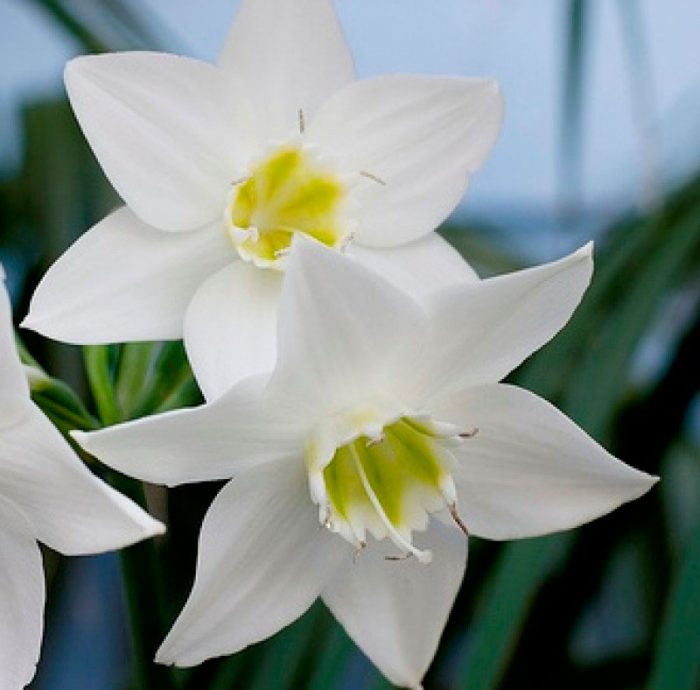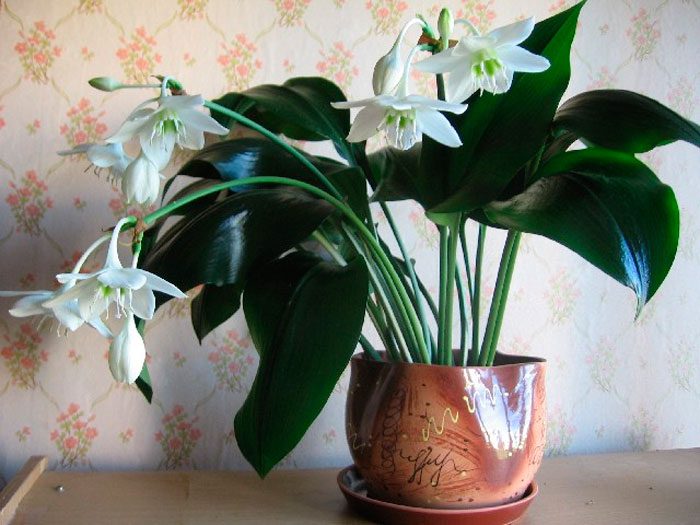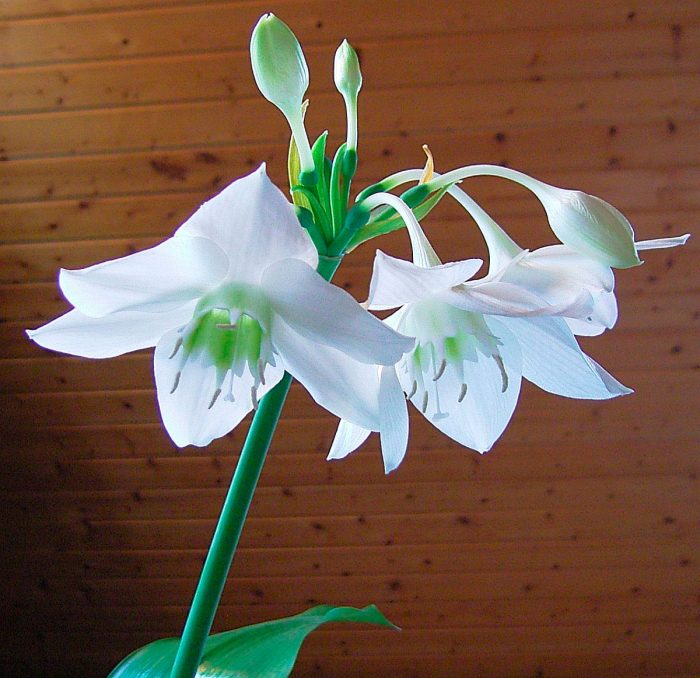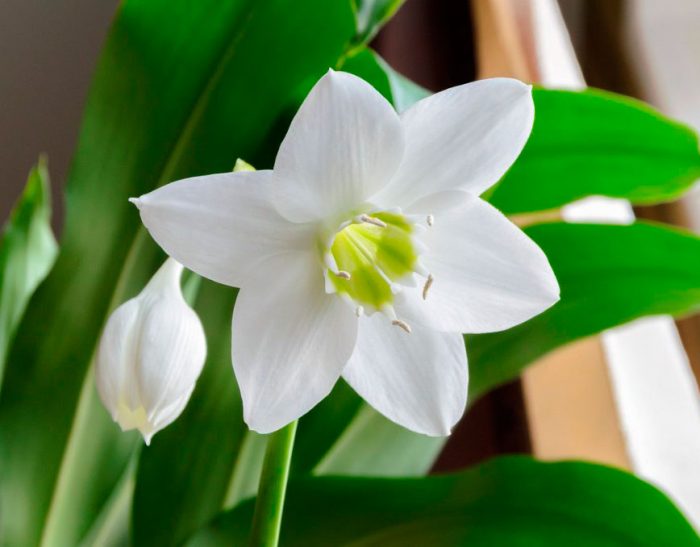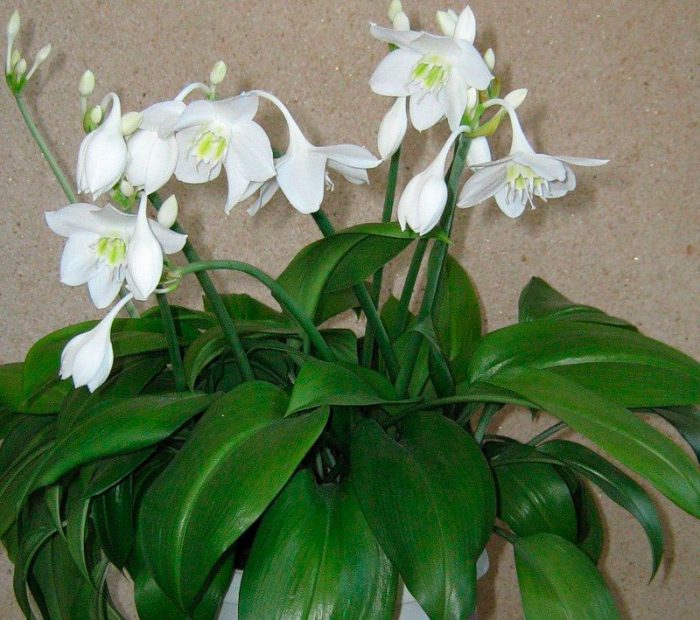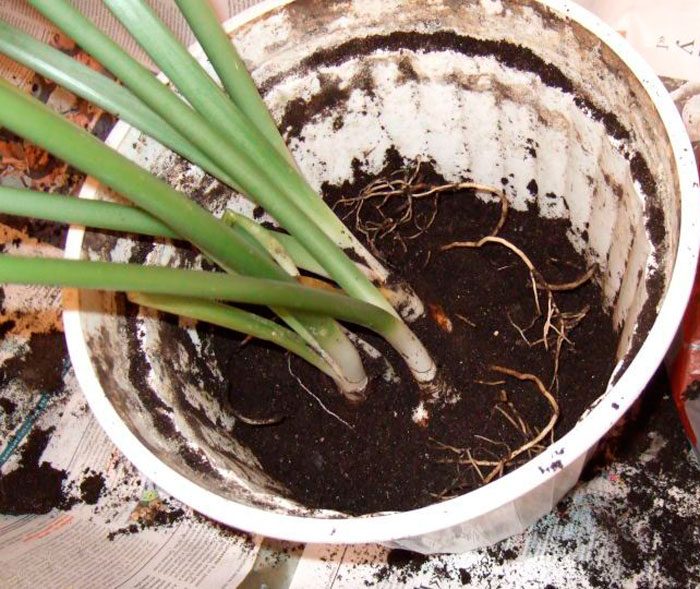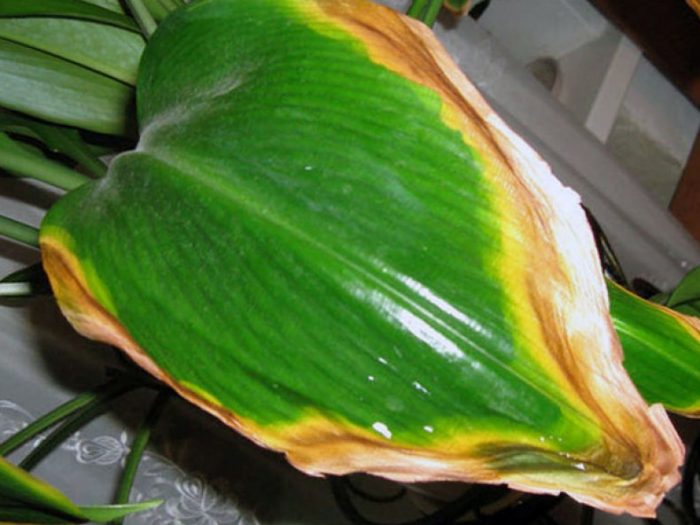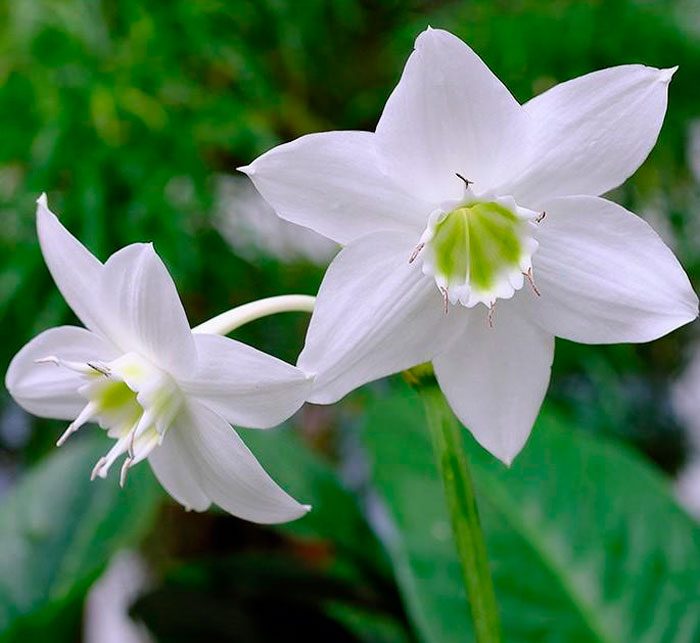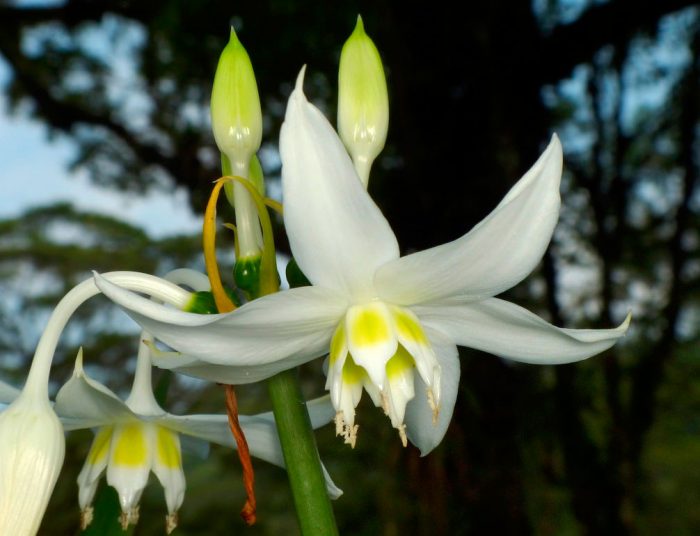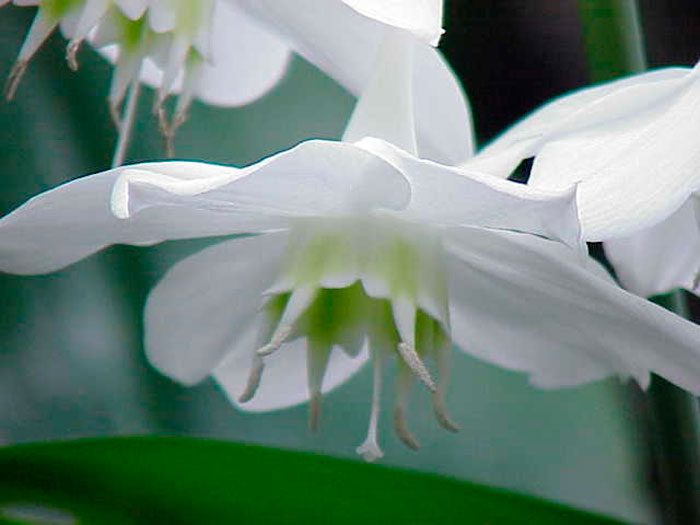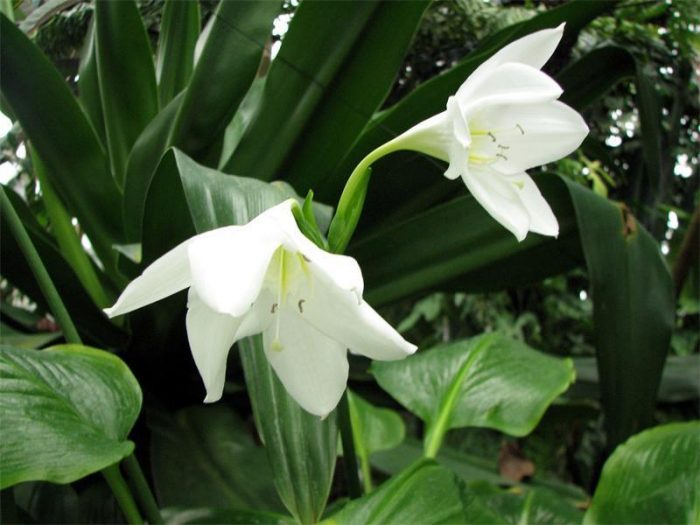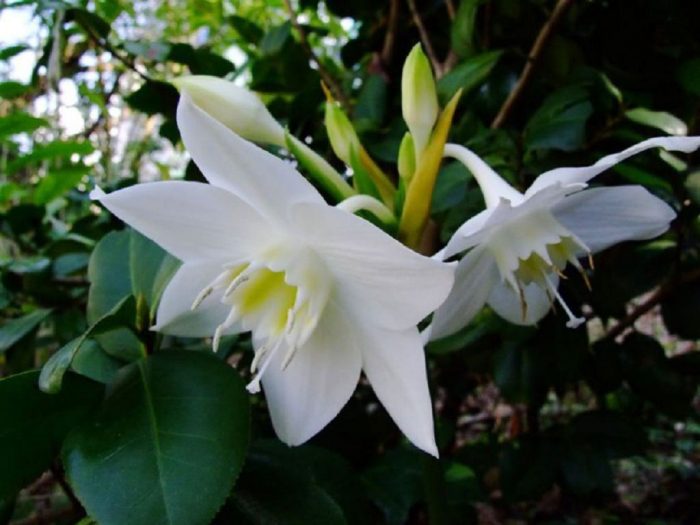Bulbous plant lily eucharis (Eucharis) is a member of the Amaryllis family. This genus unites about 20 species. From Greek "eucharis" is translated as "graceful", it is associated with the beautiful flowers and foliage of this plant. It occurs naturally in South and Central America from Bolivia to Guatemala, while eucharis prefers to grow in the lower tier of humid forests in shaded areas. This plant is also called the "Amazonian lily", since the largest number of its species can be found in Colombia, on the eastern slopes of the Andes and in the western Amazon. In the first half of the 19th century, the flower was brought to Europe, where very soon it became popular with both gardeners and florists.
Content
Brief description of cultivation
- Bloom... Twice or thrice within one year.
- Illumination... It can grow in shade and in bright but diffused light.
- Temperature regime... In summer - from 18 to 22 degrees, and in winter - from 16 to 18 degrees.
- Watering... During the growing season, water is regularly watered twice a week, and during the dormant period, immediately after the top layer of the soil mixture dries out.
- Air humidity... It should be high, so you need to systematically moisten the foliage of the plant from a spray bottle, and moistened pebbles should be poured into the pan.
- Fertilizer... During the growing season, the bush is fed once every 2 weeks, for this, liquid fertilizer is used for flowering plants with a low nitrogen content.
- Dormant period... In such a plant, it is not pronounced. However, after it has faded, it is recommended to let it rest for 4-6 weeks.
- Transfer... It is carried out immediately at the end of flowering 1 time in 3 or 4 years.
- Reproduction... Children and the seed method.
- Harmful insects... Aphids, scale insects, spider mites and thrips.
- Diseases... Red burn (staganosporosis) and gray rot.
Features of eucharis
Eucharis amazonian is a bulbous plant. The bulbs are spherical in diameter up to about 60 mm. On one bush, from 2 to 7 dark green leaf plates are formed, they are wide, lanceolate and have thick long petioles.The length of the leaves is about 0.55 m, and their width is up to 0.2 m. The foliage has a slightly wrinkled structure, as well as a protruding longitudinal vein. Flowering begins in August or September, while flower stalks grow about 0.8 m long. Outwardly, the fragrant flowers are very similar to daffodils, they are white and large, collected in 3-10 pieces in umbrellas. And the flowers also have a crown, the color of which can be yellow or green, depending on the species. The fruit is a leathery three-chambered capsule.
Home care for eucharis
It is quite simple to grow a lily eucharis, but before purchasing a flower, you need to take into account that it needs a lot of free space. For the rest, this culture is unpretentious and undemanding.
Illumination
Such a flower grows well in any light. It can be placed on either the south or north window, and it will grow well and look great everywhere. However, the bush must be shaded from the scorching midday rays of the sun, otherwise burns may appear on its surface.
Temperature regime
The flower grows best at temperatures between 18 and 22 degrees. Even in winter, the bush does not need a cool content, the recommended air temperature during this period is from 16 to 18 degrees. However, the plant reacts negatively to drafts and sudden changes in temperature, because of them the flowers become smaller, and the flowering becomes more scarce.
Watering
During the growing season, the flower should be watered regularly a couple of times a week. During the rest period, the frequency of watering is slightly reduced. Pay attention to the state of the substrate. Do not allow the clod to dry out completely, but between waterings, the top layer of the substrate must definitely dry out. Also, make sure that there is no stagnation of liquid in the soil, otherwise rot may appear on the bulb.
Air humidity
Since eucharis naturally grows in the tropics, it needs high humidity. Therefore, it must be systematically moistened from a sprayer with well-settled water at room temperature. You need to moisten the flower regularly at any time of the year, special attention should be paid to spraying in the autumn-winter period, when the air humidity becomes very low due to operating heating devices. If, to increase the humidity, some humidification from the sprayer is not enough, the flower pot must be placed on a pallet, into which moistened pebbles are poured. And sometimes eucharis should have a warm shower, or the foliage can be wiped with a damp soft cloth. From the moment the peduncles are formed, the moisture from the sprayer must be suspended until the end of flowering. Otherwise, if water drops fall on the buds and flowers, they will begin to turn brown.
Top dressing
The plant is fed regularly, but only during the growing season, and even during flowering. The regularity of dressings is 1 time in half a month. For this, it is recommended to use liquid mineral fertilizers for flowering indoor plants with a low nitrogen content, for example, Bone Forte, Agricola or Fertika-Lux. Some growers prefer to feed eucharis alternately with organic matter and mineral fertilizers. Immediately after the end of flowering, all feeding should be stopped.
Eucharis transplant
The transplant is carried out infrequently, only once every 3 or 4 years after the end of flowering, when a dormant period has already begun. This must be done very carefully, since the earthen lump must remain intact during transplantation, because the culture reacts to trauma to the root system, as well as to violations of the position of the roots, extremely negatively. The soil mixture is fertile, which includes sod, leafy and fibrous peat soil, as well as sand and rotted cow dung. The planting pot is used not very high, but wide.A layer of drainage 20 mm thick is poured onto its bottom, after which a bulb is placed in it together with a lump of earth, as a result, it should be at a depth of 40 to 50 mm. Gradually add fresh substrate and compact it, try to fill all the voids. During transplantation, it is not recommended to separate the daughter bulbs from the mother and plant them in individual containers, since children planted alone will not bloom for a long time.


Watch this video on YouTube
Post-flowering care
Eucharis differs from other representatives of the Amaryllis family in that it does not have a pronounced dormant period. He does not discard foliage. However, he needs rest before the next flowering. In this regard, at the end of flowering, pick off all wilted flower stalks, stop fertilizing the substrate, and also gradually reduce watering. The bush should rest for at least 4-6 weeks. If desired, it can be moved to a cooler room for this time, but this is not necessary. When young offspring appear on the flower, it is necessary to start gradually increasing the frequency of watering.
Reproduction methods
Sometimes the eucharis lily is propagated by seed, however, children are most often used for this. The culture differs from other bulbous plants in that the bush and the mother bulb are divided in such a way that each of the divisions contains 4 or 5 bulbs. Thanks to this, the roots will receive less damage, and the delenki themselves will undergo transplantation less painfully, move faster into growth and begin to grow overgrown with daughter bulbs. Blossoming of delenok can often be seen in the year of transplantation.
Growing eucharis from seeds takes a lot of time and effort from the grower. Moreover, the first flowering of plants grown from seeds can be seen only 5 years after the emergence of seedlings.


Watch this video on YouTube
Diseases and pests
Pests
Eucharis has a fairly high resistance to pests, however, scabbards, thrips or spider mites sometimes settle on it. Most often, those plants that are improperly looked after are affected by them. In order to exterminate such insects, you will have to spray the bush with a systemic insecticidal drug (for example, Fitoverm or Aktellik), they can be found on the shelf of any specialized store. However, it is better to provide the plant with proper care and optimal conditions for growth, then pests will bypass it.
Diseases
Most often, the culture suffers from gray rot. As a rule, the development of such a disease is facilitated by high humidity in a cool room. As soon as you notice the first signs of the disease, it will be necessary to sharply reduce the watering, then the bush is sprayed with a solution of the agent used to combat gray rot, for example: Champion, Bordeaux mixture or Topaz (at the initial stage of the disease). All severely affected areas on the bush are cut out to healthy tissue. In this case, it will be necessary to treat the wounds with a contact agent containing copper, for example: cuproxate, copper sulfate or oxychom.
Possible problems
If such a plant is improperly looked after, then problems may arise with it:
- Eucharis does not bloom... If you take care of the bush correctly, then it will bloom 2, and sometimes 3 times during the year. However, it happens that the eucharis does not want to bloom. To fix this, you first need to understand why this is happening. In order for the transplanted cut to bloom as soon as possible, it must include several bulbs. This is because one bulb, planted in a separate pot, will not bloom until many children have grown, and this usually takes 3-5 years. This is the most common reason for the lack of flowering. Another bush may not form flowers due to sudden changes in temperature or drafts.In this case, it will be enough to start looking after the plant correctly, and it will bloom regularly again.
- How to make it bloom? To do this, for the winter, the bush is placed in a shaded and cool place, watering is greatly reduced (the clod of earth in the pot should dry out almost completely), and you should also stop fertilizing the soil. As a result, with the onset of spring, the bush will begin to grow actively and will certainly delight you with lush flowering.
- Yellow foliage... In the event that only one or two sheet plates have become yellow, then this is a completely natural process. But if the foliage turns yellow massively, and even specks of a dark color appear on its surface, this means that urgent measures must be taken to save the flower. Yellowing of the foliage is observed when: the plant does not have enough water due to excessively scarce or rare watering, liquid regularly stagnates in the soil mixture, and also due to hypothermia of the bush.
- Flying around foliage... In the event that the foliage not only turns yellow, but also dies off, it is necessary to remove the bush from the pot and carefully examine its root system. Cut out any areas affected by rot and apply charcoal powder to the wounds. After that, the bush is planted in a fresh substrate. At first, the eucharis should be warm, and it is also provided with moderate watering and reliable protection from direct sunlight. If there are no rotten areas on the root system, then foliage flying around is associated with improper care.


Watch this video on YouTube
Eucharis species with photos and names
The types of eucharis that are most often grown by flower growers will be described below.
Eucharis grandiflora (Eucharis grandiflora)
This species comes from the Colombian Andes. Its bulb in diameter reaches from 30 to 60 mm. Long-petioled leaf plates have a broad-lanceolate shape. On a peduncle 0.6 to 0.8 meters long, white fragrant flowers are formed, reaching about 12 centimeters in diameter, they are collected in inflorescences by 3-6 pieces. Bloom is observed in May, August and winter.
Eucharis white (Eucharis candida)
The birthplace of this plant is also Colombia. The diameter of the bulb is about 50 mm, it has an ovoid shape. Broadly elliptical leaf plates sharpen towards the top, and narrow towards the base, their width is up to 0.15 m, and the length is about 0.4 m. An umbrella is formed on a brownish-green peduncle, consisting of 6-10 fragrant white flowers. Flowering occurs in March.
Eucharis mastersii
This species, like the white eucharis, is native to Colombia, and these plants also have bulbs of similar shape and size. The shape of the leaf plates is broadly oval, while at the base they are round, located on not too long petioles. The leaves are about 15 centimeters wide and about 25 centimeters long. The peduncle in cross section is round, as a rule, 2 umbellate inflorescences grow on it at once. The plant blooms in March.
Eucharis Sanderi
The homeland of this species is South America. His bulbs have an ovoid shape. The length of the broad-oval cordate leaf plates at the base is about 0.3 m, and the width is up to 0.17 m, they are located on long petioles (about 15 centimeters). An umbellate inflorescence is formed on a rounded peduncle, consisting of 2-3 white flowers. However, there is also a multi-flowered form, in which the inflorescence consists of 4-6 small flowers. The color of the crown rim is pale yellow. Bloom is observed in February – April. As a rule, the species is cultivated on an industrial scale.
Eucharis toothless (Eucharis subedentata)
The forests of Colombia are also considered the homeland of this species. The shape of the bulb is oval. The oblong-triangular leaf plates are about 11 centimeters wide and up to 23 centimeters long, as well as long grooved petioles. Umbrella-shaped inflorescences are formed on a narrow peduncle, consisting of 6-8 white flowers.
The most popular among flower growers is the large-flowered eucharis.


Watch this video on YouTube

